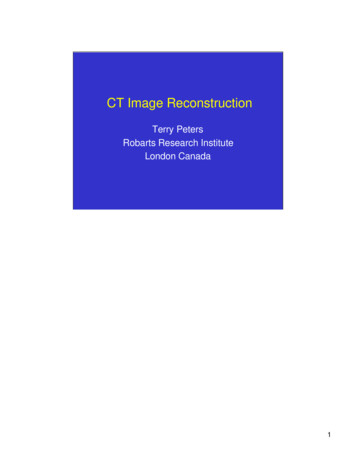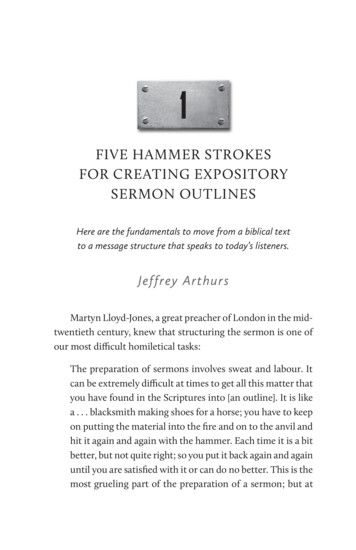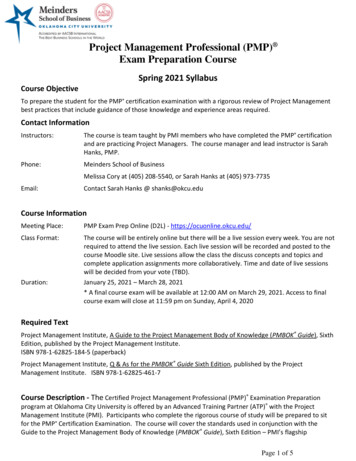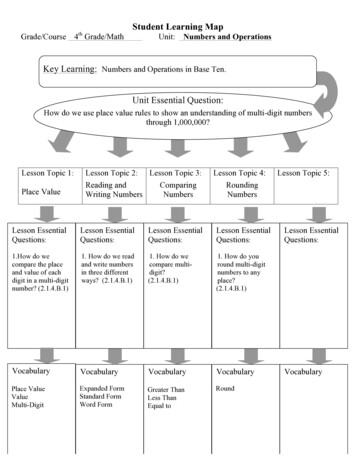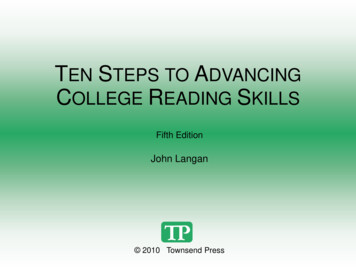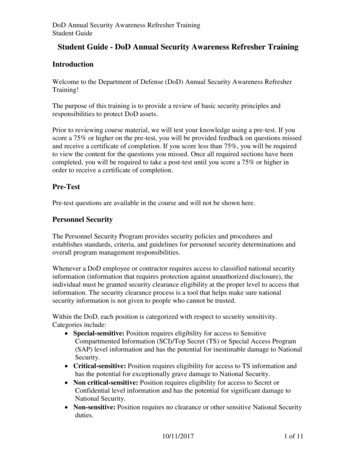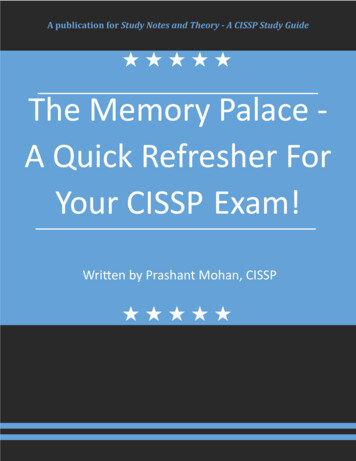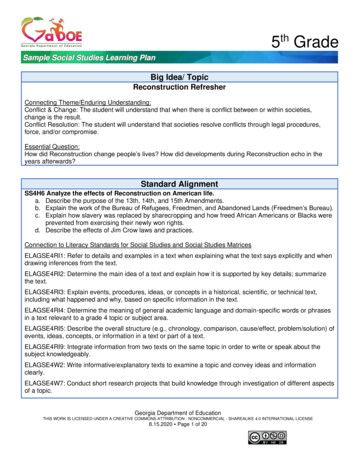
Transcription
5th GradeSample Social Studies Learning PlanBig Idea/ TopicReconstruction RefresherConnecting Theme/Enduring Understanding:Conflict & Change: The student will understand that when there is conflict between or within societies,change is the result.Conflict Resolution: The student will understand that societies resolve conflicts through legal procedures,force, and/or compromise.Essential Question:How did Reconstruction change people’s lives? How did developments during Reconstruction echo in theyears afterwards?Standard AlignmentSS4H6 Analyze the effects of Reconstruction on American life.a. Describe the purpose of the 13th, 14th, and 15th Amendments.b. Explain the work of the Bureau of Refugees, Freedmen, and Abandoned Lands (Freedmen’s Bureau).c. Explain how slavery was replaced by sharecropping and how freed African Americans or Blacks wereprevented from exercising their newly won rights.d. Describe the effects of Jim Crow laws and practices.Connection to Literacy Standards for Social Studies and Social Studies MatricesELAGSE4RI1: Refer to details and examples in a text when explaining what the text says explicitly and whendrawing inferences from the text.ELAGSE4RI2: Determine the main idea of a text and explain how it is supported by key details; summarizethe text.ELAGSE4RI3: Explain events, procedures, ideas, or concepts in a historical, scientific, or technical text,including what happened and why, based on specific information in the text.ELAGSE4RI4: Determine the meaning of general academic language and domain-specific words or phrasesin a text relevant to a grade 4 topic or subject area.ELAGSE4RI5: Describe the overall structure (e.g., chronology, comparison, cause/effect, problem/solution) ofevents, ideas, concepts, or information in a text or part of a text.ELAGSE4RI9: Integrate information from two texts on the same topic in order to write or speak about thesubject knowledgeably.ELAGSE4W2: Write informative/explanatory texts to examine a topic and convey ideas and informationclearly.ELAGSE4W7: Conduct short research projects that build knowledge through investigation of different aspectsof a topic.Georgia Department of EducationTHIS WORK IS LICENSED UNDER A CREATIVE COMMONS ATTRIBUTION - NONCOMMERCIAL - SHAREALIKE 4.0 INTERNATIONAL LICENSE8.15.2020 Page 1 of 20
ELAGSE4W8: Recall relevant information from experiences or gather relevant information from print anddigital sources; take notes and categorize information and provide a list of sources.Information Processing Skills: Compare similarities and differences; identify issues and/or problems andalternative solutions; identify main idea, detail, sequence of events, and cause and effect in a social studiescontext; identify and use primary and secondary sources; analyze artifacts; draw conclusions and makegeneralizations; interpret political cartoonsDISCLAIMERThe books used as examples for the Georgia Home Classroom’s Digital Learning Plans were selected by Georgia teachers to reinforce skillsand knowledge found within the Georgia Standards of Excellence. The Georgia Department of Education (GaDOE) cannot and does notendorse or promote any commercial products, including books. Therefore, the books that were selected serve as examples and are notendorsed or recommended by the GaDOE.Please remember that when selecting books to support instruction, Georgia’s public school teachers and leaders should consult their localschool district’s policy for determining age and content appropriateness for their students.Children’s Literature: The Georgia Council for the Social Studies offers a list of book titles aligned to the Social Studies GSE on their literatureInstructional DesignBefore this lesson: Students may have missed the Civil War unit or need a quick refresher before doing this lesson, whichis meant to teach quickly and creatively the previous grade’s Reconstruction standard in a way that 5th graders will needto grasp before moving into their 5th grade standards. If they missed all of the Civil War standard, you will need to makesure they have the basics – causes, events, people, outcome, and effects as efficiently as you can manage.*This lesson has a flexible timeline and will cross over several days.This lesson is intended to reach students in a virtual setting, whether plugged or unplugged. Seebottom of lesson for list of unplugged supplies.Note to teachers on images: Some of the images used in these lesson materials have layered andcomplex meanings. You may want to build in time for students to analyze these images more closelyand discuss what messages are being conveyed.Part 1:Ask your students to tell you what they know about the Civil War to gauge whether they are ready for thislesson. They will need to have grasped the basics in order to understand the coming lesson.Show your students a copy of the Emancipation Proclamation and ask them to respond to the prompts on theNational Archives document analysis sheet – online they can work in groups if you’re able to segment themlike that, and then share out whole group, or they can respond independently and be ready to share or posttheir findings. The form is attached in this lesson or you can download ns/worksheets/written document analysis worksheet.pdfAfter discussing the document, have students read the information overviewing the Emancipation Proclamationfound at: ts-emancipation-proclamation You can read throughas a group online together, or you can ask students to read and summarize the top five things they learned intheir notebooks or other record of their learning. Students could also watch a video summarizing theEmancipation Proclamation in 4 minutes at tionproclamation You will want to have students share their learning from either of these two sources in grouponline discussion or capture their learning in notes. [The websites or informational text you have your studentsGeorgia Department of EducationTHIS WORK IS LICENSED UNDER A CREATIVE COMMONS ATTRIBUTION - NONCOMMERCIAL - SHAREALIKE 4.0 INTERNATIONAL LICENSE8.15.2020 Page 2 of 20
explore for this segment will vary depending on district resources and may include informational texts in bookform, online children’s encyclopedias, or other kid-friendly reliable websites.]*Unplugged variation – Print a copy of the Emancipation Proclamation (a copy is included in this lessonresources packet, along with a transcript) and a hard copy of the National Archives document analysis form.Access a downloadable copy /worksheets/written document analysis worksheet.pdfStudents will also need an informational text piece about the Emancipation Proclamation in place of the digitalresources above, such as “Emancipation Proclamation facts for Kids” provided with this lesson.Part 2: Share the read aloud, All Different Now: Juneteenth, the First Day of Freedom, by Angela Johnson,illustrated by E. B. Lewis. Ask students to imagine a time in their lives when everything seemed to change:their own “all different now” moment. What were their first thoughts? What were the challenges? What were thejoys? Tell them that this book is about a dramatic change in the lives of enslaved people in West Texas in midJune of 1865.After reading and discussing the book, including the author’s and illustrator’s notes and other back matter, askstudents to write, draw, or act out what they think will happen next. Why do they think that will happen?Ask students to tie this story to what we learned earlier about the Emancipation Proclamation. How are theyconnected? Ask students for evidence to support their claim and record these in writing.*Unplugged variation to All Different Now read aloud live – If students can access YouTube videos viaphone, ask them to view and listen to a read aloud of All Different Now. There are many other videos onlineabout Juneteenth, including read alouds of other picture books; you may wish to screen these in order to makerecommendations to your students. Note that read aloud links may change on the Internet. Review thoseavailable about Juneteenth and choose one that best fits your needs.If you have copies of this or other book titles to lend to students, include them in their take home kits.After reading or hearing the book, including the author’s and illustrator’s notes and other back matter, askstudents to write, draw, or create a script for what they think will happen next. Why do they think that willhappen?Ask students to tie this story to what we learned earlier about the Emancipation Proclamation. How are theyconnected? Ask students for evidence to support their claim and have them record their thoughts in writing*Unplugged variation if you cannot share the read aloud All Different Now as discussed above – Askyour students to write their own story of finding out the news about emancipation. How do we imagine thoseformerly enslaved people hearing about their freedom for the first time might have reacted? What would theyhave thought, said, done, or felt? How would they have celebrated or observed the occasion? Write your ownpicture book telling this story. When you have the opportunity, compare your story to that of Angela Johnson’sbook.Part 3: In an online lesson, read and discuss the Reconstruction Basics informational text together. You maywant to share this document ahead of time, especially for students who may need extra support. While youread through the information, model for students with a “Think Aloud” how historians read and the questionsthey are asking themselves while they read. Examples of questions to model: If I were rebuilding a country that had been divided through war, what kinds of things would I need to bethinking about?Why did it take 3 amendments to provide a way for formerly enslaved people to become full citizens?Do you think these will be enough? Who is NOT included in these amendments?Georgia Department of EducationTHIS WORK IS LICENSED UNDER A CREATIVE COMMONS ATTRIBUTION - NONCOMMERCIAL - SHAREALIKE 4.0 INTERNATIONAL LICENSE8.15.2020 Page 3 of 20
What are some of the problems you can imagine that the Freedman’s Bureau faced in meeting itsmission?Compare and contrast enslavement with sharecropping.What do I imagine the effects of the KKK and Jim Crow laws are on newly freed individuals?What questions do I still have about this period of time?After reading the document together once, assign students to re-read it and then use the information tocomplete the graphic organizer provided.*Unplugged variation to Reconstruction Basics lesson – Assign students to read the ReconstructionBasics informational text piece included in this lesson materials. As they read, have them mark up or annotatethe text to identify the most important information. Directions for annotation are included on this document.After reading and annotating, ask students to record their learning on the graphic organizer provided.For a summative assessment: Direct students to: Use the picture cards provided to show what you know.Make 3 way matches of cards that connect in some way. Provide the evidence to support your connections.For those participating online, students can share their connections and rationales orally or within theirnotebooks or both.Unplugged variation to Reconstruction assessment - Use the picture cards provided to show what youknow. Make 3 way matches of cards that connect in some way. Provide the evidence to support yourconnections. Record these matches or paste them into your notebook, along with your evidence for these.Make at least 3 sets of matches.An alternative assessment (plugged or unplugged) - Have students answer the essential questions for thislesson by writing a good paragraph or two responding to the questions and providing evidence to support theirclaims. To answer the essential question students could also: create a timeline, write a comic strip, write anewspaper article, record a “news report”, record a skit, create an infographic, etc.Georgia Department of EducationTHIS WORK IS LICENSED UNDER A CREATIVE COMMONS ATTRIBUTION - NONCOMMERCIAL - SHAREALIKE 4.0 INTERNATIONAL LICENSE8.15.2020 Page 4 of 20
Student Learning SupportsIdeas for Differentiation:Our goal is for all students to be actively engaged using speaking, writing, illustrating. reading, and listening.Below are changes to the lesson to help achieve that goal for students who need additional support. Note: Ifstudents are able to complete the activities on their own, it would be best to let them do this independently. Consider allowing students to record their thoughts in a variety of ways: using the talk totext/dictate feature, making an audio recording of their responses, drawing pictures, circling and/orlabeling on the documents or images provided, etc.Consider providing students a sample 3 way match with reasoning included. Consider providingstudents with 2 matches and have students find a 3rd match and share their thinking. Considerproviding a 3 way match and have students share how the matches go together or provide studentswithConsider reading research materials to students or copying materials into a Word document toallow students to use the “read aloud” feature.Opportunities for Extension:Explore additional resources on Juneteenth such as those listed here: https://www.slj.com/?detailStory rary.gov/es/tx/es tx june 1.htmlOther children’s books:Juneteenth for Mazie by Floyd CooperJuneteenth Jamboree by Carol Boston WeatherfordCelebrating Holidays: Juneteenth by Rachel Koestler-GrackHolidays and Heroes: Let’s Celebrate Emancipation Day and Juneteenth by Barbara deRubertisJuneteenth by Julie Murray Most states have declared Juneteenth a state holiday or given it special recognition, but it has not yetbeen declared a national holiday or day of observance. Should it be? Why or why not? Write a letter tothe editor, a hip-hop song, a poem, a persuasive paragraph, or a skit script or design a poster orpamphlet to convince others of your position. Compare and contrast the celebration of Juneteenth with the 4th of July. What are your thoughts aboutthese two holidays and why they are celebrated the ways that they are? Share in writing or orally.Unplugged Supplies: Lesson checklist Interactive notebook or something to take notes on Emancipation Proclamation primary source Emancipation Proclamation typed transcript National Archives document analysis sheet Handout – Informational Text “The Emancipation Proclamation for Kids”Georgia Department of EducationTHIS WORK IS LICENSED UNDER A CREATIVE COMMONS ATTRIBUTION - NONCOMMERCIAL - SHAREALIKE 4.0 INTERNATIONAL LICENSE8.15.2020 Page 5 of 20
Copy of book All Different Now to send with packet if available.Blank drawing paperCrayonsScissorsGlue sticksColored pencilsReconstruction Basics informational textGraphic Organizer for Reconstruction Basics3 Way Match cards – text only3 Way Match cards – text with picturesEvidence of Student SuccessInformation for diagnostic, formative, and summative assessments are described within the InstructionalDesign.Engaging FamiliesMaterials included to support unplugged learners: Lesson checklist, Emancipation Proclamation primarysource, Emancipation Proclamation typed transcript, National Archives document analysis sheet, Handout –Informational Text “The Emancipation Proclamation for Kids,” Reconstruction Basics informational text,Graphic Organizer for Reconstruction Basics, 3 Way Match cards – text only, 3 Way Match cards – text withpictures,Optional materials to support learning not included: blank paper, interactive notebook or something to takenotes on, blank drawing paper, crayons, scissors, glue sticks, colored pencils, etc., copy of the book AllDifferent Now or alternative children’s book, as available.Georgia Department of EducationTHIS WORK IS LICENSED UNDER A CREATIVE COMMONS ATTRIBUTION - NONCOMMERCIAL - SHAREALIKE 4.0 INTERNATIONAL LICENSE8.15.2020 Page 6 of 20
Reconstruction Refresher Lesson ChecklistStandard: SS4H6 Analyze the effects of Reconstruction on American life.a. Describe the purpose of the 13th, 14th, and 15th Amendments.b. Explain the work of the Bureau of Refugees, Freedmen, and Abandoned Lands (Freedmen’s Bureau).c. Explain how slavery was replaced by sharecropping and how freed African Americans or Blacks were prevented fromexercising their newly won rights.d. Describe the effects of Jim Crow laws and practices.Essential Questions: How did Reconstruction change people’s lives? How did developments duringReconstruction echo in the years afterwards?Part 1: 1. Review the standard listed above and highlight any words you are unsure of now. As you go throughthe activities of this lesson, check back on the standard to see if you are able to rephrase or define thewords and concepts you were unsure of at first. 2. Jot the essential questions above into your notebook and leave that page blank for now. As youwork through the activities, add bullet pointed notes that will help you be able to answer the EQ’s by theend of the lesson. 3. Examine the Emancipation Proclamation (you do not need to read all the words, just the ones youare able to figure out) and complete the National Archives document analysis sheet to record yourresponses. Skim the transcript of the Emancipation Proclamation (the typed copy of the words) to see ifyou can get the main ideas of it. Jot these down into your notebook. You can use both words andsketches to show what you know. 4. Read the informational text provided called “Emancipation Proclamation facts for Kids.” Tell 3 factsyou learned and 2 questions you still have. Draw a sketch under your writing to help capture some ofyour learning.Part 2: 5. View and listen to a read aloud of All Different Now: Juneteenth, the First Day of Freedom, byAngela Johnson, illustrated by E. B. Lewis. You may want to pause the video every couple of minutesin order to jot down notes or ideas you are learning about or thoughts and questions you may have.Note that read aloud links may change on the Internet. Review those available online about Juneteenthand choose one that best fits your needs. 6. After reading or hearing the book, including the author’s and illustrator’s notes and other back matter,write, draw, or create a script for what you think will happen next. Why do you think that will happen? Ifyou do not have access to the book, Write your own picture book telling what formerly enslaved peoplemight do when they discover they are free. Use what you have learned to make the story realistic. Howdo we imagine those formerly enslaved people hearing about their freedom for the first time might havereacted? What would they have thought, said, done, or felt? How would they have celebrated orobserved the occasion? When you have the opportunity, compare your story to that of AngelaJohnson’s book. 7. Tie this story to what we learned earlier about the Emancipation Proclamation. How are theyconnected? Provide evidence to support you claim and record your thoughts in writing in yournotebook.Georgia Department of EducationTHIS WORK IS LICENSED UNDER A CREATIVE COMMONS ATTRIBUTION - NONCOMMERCIAL - SHAREALIKE 4.0 INTERNATIONAL LICENSE8.15.2020 Page 7 of 20
Reconstruction Refresher Lesson ChecklistPart 3: 8. Read the Reconstruction Basics informational text piece included in the lesson materials. As youread, mark up or annotate the text to identify the most important information. Directions for annotationare included on this document. After reading and annotating, record your learning on the graphicorganizer provided. 9. Reconstruction Assessment - Use the picture cards provided to show what you know. Make 3 waymatches of cards that connect in some way. Provide the evidence to support your connections. Recordthese matches or paste them into your notebook, along with your evidence for these. Make at least 3sets of matches. 10. Answer the Essential Questions: Write a good paragraph or two responding to the questions (seethe top of the checklist) and provide evidence to support your claims. Other options for answering theessential questions might include: create a timeline, write a comic strip, write a newspaper article,record a “news report”, record a skit, create an infographic, etc.Georgia Department of EducationTHIS WORK IS LICENSED UNDER A CREATIVE COMMONS ATTRIBUTION - NONCOMMERCIAL - SHAREALIKE 4.0 INTERNATIONAL LICENSE8.15.2020 Page 8 of 20
Next Steps:This lesson sets students and teacher up perfectly for the first fifth grade unit and the standardson due process and the amendment process (see below). Since students would have just beenspent time focusing on the Reconstruction Amendments, they can then more easily build on whatthey have just learned. These upcoming standards are:SS5CG1 Explain how a citizen’s rights are protected under the U.S. Constitution. a. Explainthe responsibilities of a citizen. b. Explain the concept of due process of law and describe howthe U.S. Constitution protects a citizen’s rights by due process.SS5CG2 Explain the process by which amendments to the U.S. Constitution are made. a.Explain the amendment process outlined in the Constitution. b. Describe the purpose for theamendment process.They will also have gained an essential understanding of Jim Crow and some unmet goals ofReconstruction as a background for understanding continued Jim Crow practices and laws in thelate 19th and the 20th centuries. This all lays a foundation for understanding the continuity fromabolitionism to suffrage to the civil rights movement and activism throughout our country’s history.Of course, many links can also be made to today’s protests and demands for social justice,providing an opportunity to reinforce that knowing our history and all of its complexities may helpus make better laws and better choices going forward.Georgia Department of EducationTHIS WORK IS LICENSED UNDER A CREATIVE COMMONS ATTRIBUTION - NONCOMMERCIAL - SHAREALIKE 4.0 INTERNATIONAL LICENSE8.15.2020 Page 9 of 20
Georgia Department of EducationTHIS WORK IS LICENSED UNDER A CREATIVE COMMONS ATTRIBUTION - NONCOMMERCIAL - SHAREALIKE 4.0 INTERNATIONAL LICENSE8.15.2020 Page 10 of 20
The Emancipation Proclamation January 1, 1863A TranscriptionBy the President of the United States of America: A Proclamation.Whereas, on the twenty-second day of September, in the year of our Lord one thousand eight hundred andsixty-two, a proclamation was issued by the President of the United States, containing, among other things, thefollowing, to wit:"That on the first day of January, in the year of our Lord one thousand eight hundred and sixty-three, allpersons held as slaves within any State or designated part of a State, the people whereof shall then be inrebellion against the United States, shall be then, thenceforward, and forever free; and the ExecutiveGovernment of the United States, including the military and naval authority thereof, will recognize and maintainthe freedom of such persons, and will do no act or acts to repress such persons, or any of them, in any effortsthey may make for their actual freedom."That the Executive will, on the first day of January aforesaid, by proclamation, designate the States and partsof States, if any, in which the people thereof, respectively, shall then be in rebellion against the United States;and the fact that any State, or the people thereof, shall on that day be, in good faith, represented in theCongress of the United States by members chosen thereto at elections wherein a majority of the qualifiedvoters of such State shall have participated, shall, in the absence of strong countervailing testimony, bedeemed conclusive evidence that such State, and the people thereof, are not then in rebellion against theUnited States."Now, therefore I, Abraham Lincoln, President of the United States, by virtue of the power in me vested asCommander-in-Chief, of the Army and Navy of the United States in time of actual armed rebellion against theauthority and government of the United States, and as a fit and necessary war measure for suppressing saidrebellion, do, on this first day of January, in the year of our Lord one thousand eight hundred and sixty-three,and in accordance with my purpose so to do publicly proclaimed for the full period of one hundred days, fromthe day first above mentioned, order and designate as the States and parts of States wherein the peoplethereof respectively, are this day in rebellion against the United States, the following, to wit:Arkansas, Texas, Louisiana, (except the Parishes of St. Bernard, Plaquemines, Jefferson, St. John, St.Charles, St. James Ascension, Assumption, Terrebonne, Lafourche, St. Mary, St. Martin, and Orleans,including the City of New Orleans) Mississippi, Alabama, Florida, Georgia, South Carolina, NorthCarolina, and Virginia, (except the forty-eight counties designated as West Virginia, and also the counties ofBerkley, Accomac, Northampton, Elizabeth City, York, Princess Ann, and Norfolk, including the cities of Norfolkand Portsmouth[)], and which excepted parts, are for the present, left precisely as if this proclamation were notissued.And by virtue of the power, and for the purpose aforesaid, I do order and declare that all persons held asslaves within said designated States, and parts of States, are, and henceforward shall be free; and that theExecutive government of the United States, including the military and naval authorities thereof, will recognizeand maintain the freedom of said persons.And I hereby enjoin upon the people so declared to be free to abstain from all violence, unless in necessaryself-defence; and I recommend to them that, in all cases when allowed, they labor faithfully for reasonablewages.Georgia Department of EducationTHIS WORK IS LICENSED UNDER A CREATIVE COMMONS ATTRIBUTION - NONCOMMERCIAL - SHAREALIKE 4.0 INTERNATIONAL LICENSE8.15.2020 Page 11 of 20
And I further declare and make known, that such persons of suitable condition, will be received into the armedservice of the United States to garrison forts, positions, stations, and other places, and to man vessels of allsorts in said service.And upon this act, sincerely believed to be an act of justice, warranted by the Constitution, upon militarynecessity, I invoke the considerate judgment of mankind, and the gracious favor of Almighty God.In witness whereof, I have hereunto set my hand and caused the seal of the United States to be affixed.Done at the City of Washington, this first day of January, in the year of our Lord one thousand eight hundredand sixty three, and of the Independence of the United States of America the eighty-seventh.By the President: ABRAHAM LINCOLN WILLIAM H. SEWARD, Secretary of State.Georgia Department of EducationTHIS WORK IS LICENSED UNDER A CREATIVE COMMONS ATTRIBUTION - NONCOMMERCIAL - SHAREALIKE 4.0 INTERNATIONAL LICENSE8.15.2020 Page 12 of 20
Reconstruction BasicsAs you read, annotate the informational text below using these symbols:SS4H6 Analyze the effects of Reconstruction on American life.a. Describe the purpose of the 13th, 14th, and 15th Amendments.b. Explain the work of the Bureau of Refugees, Freedmen, and Abandoned Lands (Freedmen’s Bureau).c. Explain how slavery was replaced by sharecropping and how freed African Americans or Blacks were preventedfrom exercising their newly won rights.d. Describe the effects of Jim Crow laws and practices.What was like life after the Civil War? Yes, there were changes, both legal and otherwise, but great challengesand inequities remained. Three amendments were added to the Constitution to reinforce the end of slavery.Though slavery was abolished, lingering prejudices in the South led to the passage of Jim Crow laws and keptmany inequities firmly in place. Former slaves often became sharecroppers and tried to make a new life forthemselves. The Freedmen’s Bureau was created to help the newly freed slaves to make the transition to newways of living.The 13th – 15th amendments are known as the Reconstruction Amendments, because they were intended tohelp reconstruct or rebuild the divided country. The 13th Amendment declared that slavery would not beallowed to exist in the United States. It ended the long argument in the United States over whether slaveryshould be legal. The 14th Amendment, also known as the due process amendment, declared that the statescould not limit the rights of citizens. States could not take away life, liberty, or property without due processof law, or deny equal protection of the law. The 15th Amendment gave all men the right to vote, no mattertheir skin color or if they had been enslaved.An organization known as the Bureau of Refugees, Freedmen, and Abandoned Lands (also known as theFreedmen’s Bureau) provided help to thousands of former slaves and poor white people in the South. Itprovided food, clothing, and medical care, and it promoted education and provided work. It gave thefreedmen land that had been abandoned. It also helped former black soldiers to receive back pay andpensions from fighting in the war. Although the Bureau had some successes, it was largely blocked frommaking permanent changes for many.Georgia Department of EducationTHIS WORK IS LICENSED UNDER A CREATIVE COMMONS ATTRIBUTION - NONCOMMERCIAL - SHAREALIKE 4.0 INTERNATIONAL LICENSE8.15.2020 Page 13 of 20
Reconstruction ended the plantation system in the South, leavin
5th Grade Sample Social Studies Learning Plan . Georgia Department of Education . The books used as examples for the Georgia Home Classroom’s Digital Learning Plans were selected by Georgia teachers to reinforce skills and knowledge found within the Georgia Standards of Excellence. The Ge



